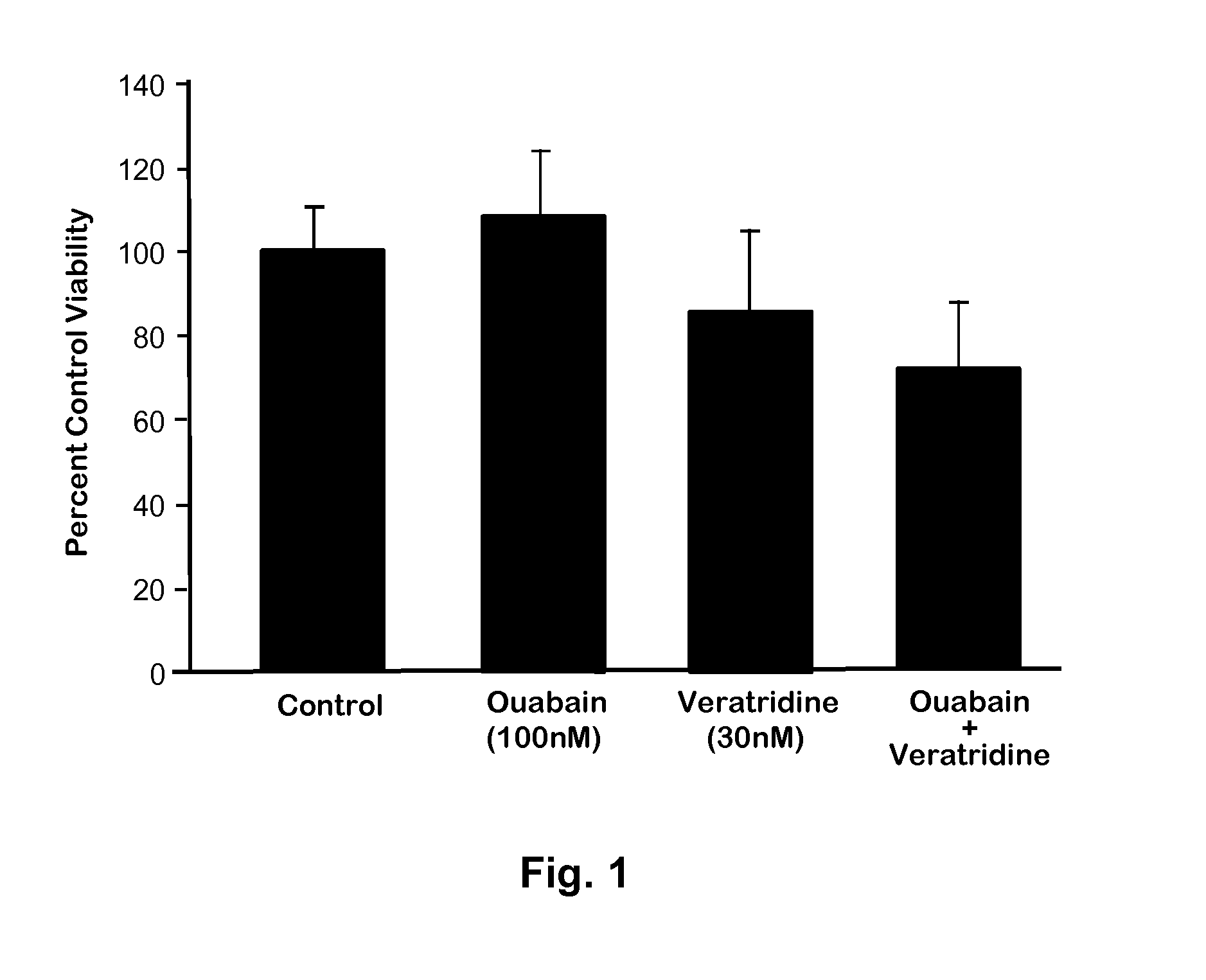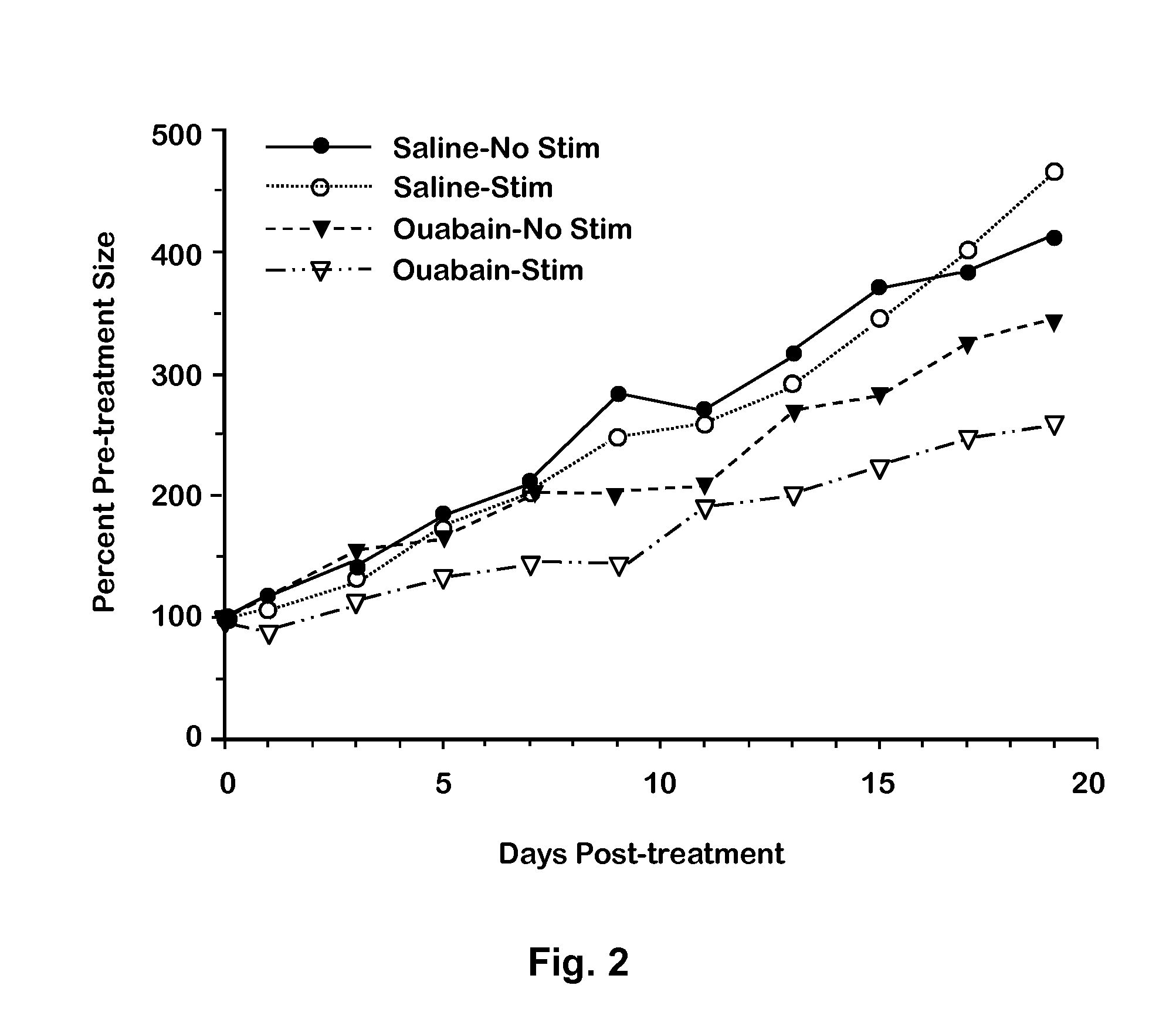Targeted osmotic lysis of cancer cells
a cancer cell and osmotic lysis technology, applied in the field of targeted osmotic lysis of cancer cells, can solve the problem that nasup>+/sup> cannot be pumped back out of the cell, and achieve the effects of increasing the expression of sodium channel, and reducing the risk of tol treatmen
- Summary
- Abstract
- Description
- Claims
- Application Information
AI Technical Summary
Benefits of technology
Problems solved by technology
Method used
Image
Examples
example 1
Targeted Osmotic Lysis in Breast Cancer Cells
[0032]The effectiveness of TOL has been tested using an in vitro model for breast cancer. MDA-MB-231 breast cancer cells were cultured to complete confluency in 96-well plates. These breast cancer cells are known to over-express VGSCs by 1400-fold. These cells were exposed to Dulbecco's modified Eagle's medium (DMEM), or the cardiac glycoside drugs (known sodium pump inhibitors) ouabain (10 pM-100 nM; Sigma Chemical Co., St. Louis, Mo.) or digitoxin (100 pM-1 μM; Sigma) dissolved in DMEM for 30 min. After exposure to the sodium pump inhibitors, an electric current (0 V, 100 mV, or 1 V DC) was passed across the cells using an anode and a cathode placed touching the bottom of each well or an etched circuit in the bottom of the plate. The electric current was generated using a Grass Model SD9 stimulator (Grass Instruments, Quincy, Mass.) through platinum wire electrodes. In 6 of 24 wells that cells were exposed to ≧1 nM ouabain or ≧10 nM dig...
example 2
Targeted Osmotic Lysis Using In Vivo Model of Cancer
[0033]As an in vivo model of cancer, MDA-MB-231 cells were suspended in matrigel and injected subcutaneously into the backs of 5 nude (J-NU) mice. Each mouse developed 0.75-1.2 cm tumors in 3-5 weeks. The mice were then injected subcutaneously with 10 mg / kg ouabain or saline. After 30 min, the mice were anesthetized with 4% isoflurane, and the tumors exposed through a small incision in the skin. An anode and a cathode were inserted into each tumor, and a train of 120 1 V DC pulses (10 msec, 2 Hz for 1 min) was delivered through the anode and cathode as discussed above. A total of 11 tumors were tested. Three tumors were from mice treated with ouabain and electrically stimulated (O-ES experimental). Of the rest, two were from a mouse treated with saline and not electrically stimulated (S-NS control), three were from mice treated with ouabain but not electrically stimulated (O-NS control), and three were from mice treated with saline...
example 3
In Vitro Targeted Osmotic Lysis of Multiple Cell Lines of Carcinoma
[0034]Initially we cultured MDA-MB-231 (ATCC, Manassas, Va., cat #HTB-26) breast cancer cells to complete confluency in 96-well plates. These cells over-express VGSCs by 100-fold. These cells were exposed to Dulbecco's modified Eagle's medium (DMEM; Invitrogen, Grand Island, N.Y.), or the cardiac glycoside drugs ouabain (10 pM-100 nM) or digoxin (100 pM-1 μM) dissolved in DMEM for 30 min. An electric current (0 V, 100 mV, or 1 V DC) was passed across the cells by means of an anode and a cathode placed touching the bottom of each well as in Example 1. In 6 of 24 wells that were exposed to ≧1 nM ouabain or ≧10 nM digoxin, all cancer cells died. Of these six wells, 1 well was exposed to 10 nM ouabain and 1 VDC, 1 was treated with 100 nM ouabain with 100 mVDC, 1 was treated with 100 nM ouabain and with 1 VDC, 2 were treated with 100 nM digoxin and with 1 VDC, and 1 treated with 1 μM digoxin and 100 mVDC.
[0035]We also use...
PUM
| Property | Measurement | Unit |
|---|---|---|
| voltage gradient | aaaaa | aaaaa |
| voltage | aaaaa | aaaaa |
| voltage | aaaaa | aaaaa |
Abstract
Description
Claims
Application Information
 Login to View More
Login to View More - R&D
- Intellectual Property
- Life Sciences
- Materials
- Tech Scout
- Unparalleled Data Quality
- Higher Quality Content
- 60% Fewer Hallucinations
Browse by: Latest US Patents, China's latest patents, Technical Efficacy Thesaurus, Application Domain, Technology Topic, Popular Technical Reports.
© 2025 PatSnap. All rights reserved.Legal|Privacy policy|Modern Slavery Act Transparency Statement|Sitemap|About US| Contact US: help@patsnap.com


